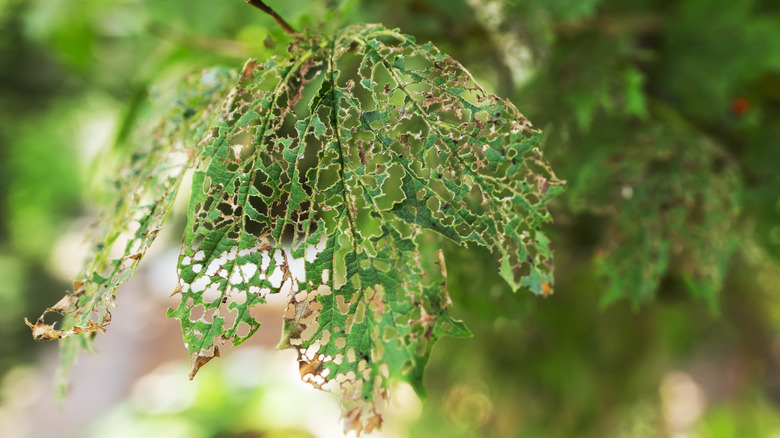The Common Pest That Wreaks Havoc In New York Gardens (& What To Do About It)
Viburnums are a stunning group of plants that are a gorgeous alternative to hydrangeas. With over 150 species of viburnum ranging from shrubs to small trees, there's no shortage of options for varieties to plant in your yard. But with viburnums' beauty comes an unfortunate pest if you live in certain areas of the U.S., especially New York: the aptly-named viburnum leaf beetle.
These beetles are small, yellowish-brown bugs whose larvae are covered in black spots. They don't just have a preference for viburnum — it's the only type of plant they attack. Viburnum leaf beetles were first reported in New York in 1996, and can now be found gnawing on viburnums across the northeastern U.S. In the spring, larvae chew lace-like patterns into leaves, which become larger oblong holes or even complete defoliation as the beetles mature and keep chewing in the summer. This damage can cause dieback or even kill plants if they continue to lose leaves over the years.
These holes are a tell-tale sign of infestation, but there are other ways to determine if that's the pest you're dealing with. Check twigs for eggs, ideally in the fall or winter while the viburnum is still leafless so the eggs are easier to spot. They look like small clusters of brown dots arranged in straight rows and are laid in tiny holes that the adult female viburnum leaf beetle has chewed into stems.
What to do about viburnum leaf beetle infestations
How to handle a viburnum leaf beetle problem depends on where the beetles are in their life cycle. It's most effective to catch the infestation before eggs hatch in mid-to-late spring, so check twigs for eggs while the beetles are inactive between October and April. Any infested twigs should then be pruned out and destroyed. Applying horticultural oil to affected areas can reduce egg hatch, but should only be done before leaves emerge since it can burn plant foliage.
If you're seeing irregular holes in skeletonized leaves in late June to early July, you're probably dealing with adult beetles. In that case, isolate the infected plant to the best of your ability. Adults aren't as affected by remedies like horticultural oil or insecticidal soap, so you may need to move on to a systemic insecticide. Imidacloprid is an effective solution, but it's considered "restricted use" in New York and is even banned from consumer products on Long Island, so it may be time to call in a pest professional.
That said, it's best if you can avoid using broad-spectrum insecticides. Besides some being restricted or banned in certain New York municipalities, these insecticides also run the risk of killing beneficial insects, including those like lady beetles that eat viburnum leaf beetles. You can bring these good insects to your garden by planting native, diverse, non-viburnum plants nearby to offer food and shelter for viburnum leaf beetles' predators.
Additional tips to avoid viburnum leaf beetle infestations
Luckily, chemicals aren't your only weapon against viburnum leaf beetles. One eco-friendly pest control method that requires no pesticides is simply planting a different variety of viburnum. Avoid the types that viburnum leaf beetles seem to prefer, like arrowwood viburnum (V. dentatum), European cranberrybush (V. opulus), American cranberrybush (V. tribolum), and Rafinesque viburnum (V. rafinesquianum). Instead, opt for a variety with a natural resistance to infestation, like Koreanspice (V. carlesii), doublefile (V. plicatum), leatherleaf (V. rhytidophyllum), and dawn (V. bodnantense) viburnums.
Many of the most susceptible viburnum plants are native to New York, so you may have to go against the typical advice of prioritizing native plants. Regardless, reconsider planting viburnum altogether if a certain species is invasive to your area; for example, tea viburnum (V. setigerum) and Japanese snowball (V. plicatum) are classified as invasive in parts of New York. Whatever you're planting, do so in a sunny spot, since viburnum leaf beetles are more likely to infest shrubs in the shade if given the option between identical plants in different locations. Choose a shade-loving companion to grow with viburnum that attracts beetle predators for good measure.


